Understanding Joint Degeneration and Its Early Signals
Joint degeneration, particularly knee osteoarthritis, is a pervasive and progressive condition affecting millions worldwide. Recognizing its early signs is crucial for timely intervention, which can significantly slow disease progression and improve quality of life. This article explores the fundamental aspects of knee joint degeneration, focusing on early recognition, diagnosis, risk factors, and management strategies to empower individuals and healthcare providers in addressing this widespread condition effectively.
What Is Knee Osteoarthritis and Why Does It Occur?
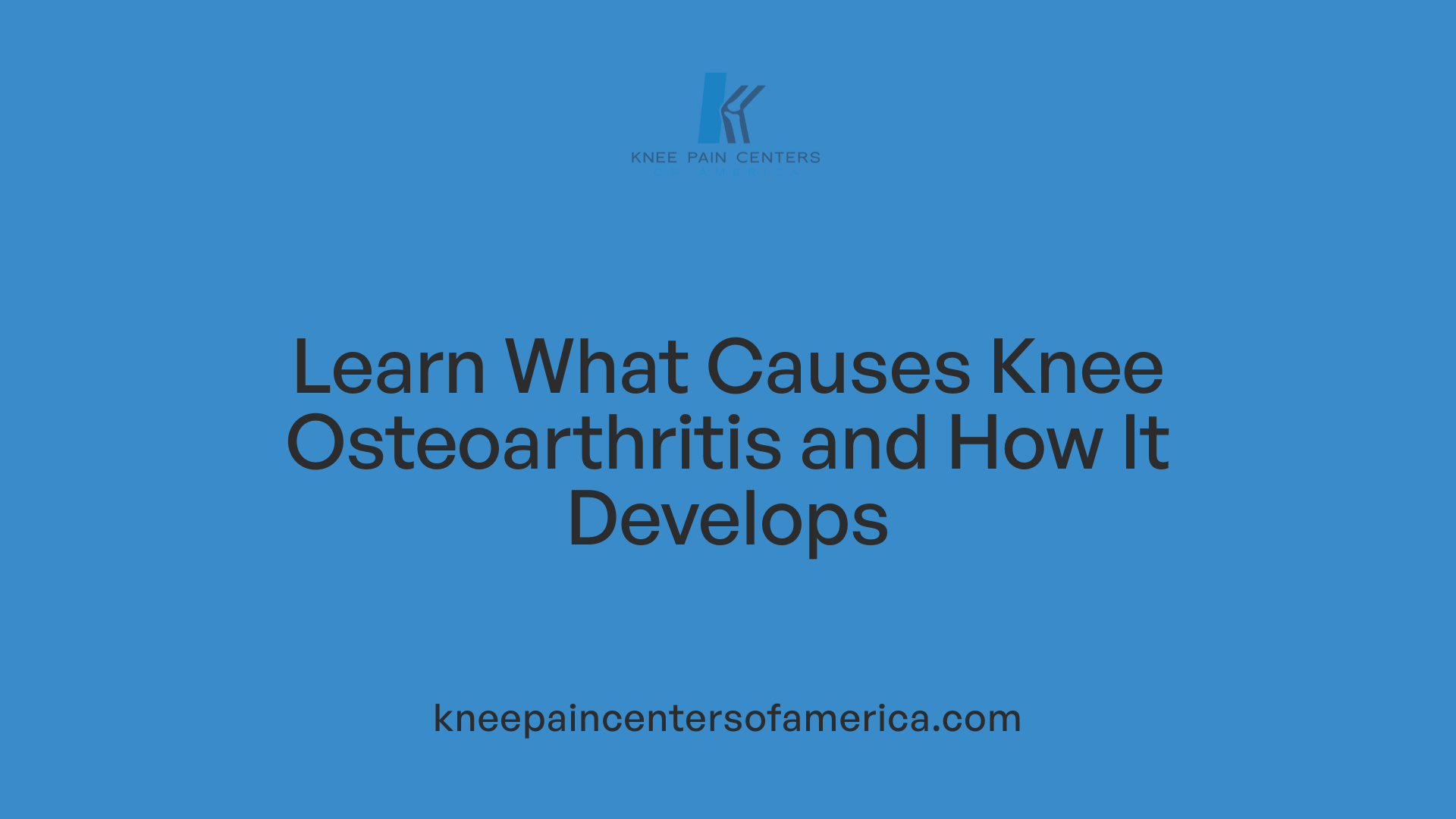
What is knee osteoarthritis and how does it develop?
Knee osteoarthritis (OA) is a degenerative joint disease marked by the breakdown of articular cartilage. This cartilage, which normally cushions the ends of bones in the knee joint, gradually wears away. As the cartilage deteriorates, bones in the joint begin to rub against each other, causing pain, stiffness, and restricted movement.
Mechanism of cartilage breakdown
The cartilage loss stems primarily from "wear and tear" caused by longstanding mechanical stress. Repeated stress on the knee joint—such as from daily activities or sports—leads to progressive cartilage degradation. As the cushioning disappears, subchondral bone (the bone beneath the cartilage) reacts by thickening and forming bone spurs (osteophytes), further contributing to joint discomfort.
Common sites affected
While osteoarthritis can affect multiple joints, the knees are among the most commonly impacted sites due to their role in supporting body weight and facilitating movement. Other frequent sites include the hips, hands, lower back, and neck.
Types of osteoarthritis: primary and secondary
Knee osteoarthritis can be categorized as:
- Primary OA: Develops without an identifiable cause, often related to aging and genetic factors.
- Secondary OA: Occurs due to known factors such as previous knee injuries, joint deformities, inflammatory diseases, or traumatic damage.
Role of wear-and-tear and other causes
The most common cause of knee OA is the mechanical wear and tear of joint cartilage over time. However, other contributing factors include:
- Joint injuries or trauma
- Excessive stress from high-impact sports or occupations
- Bone and joint deformities
- Genetic predisposition
- Obesity, which increases joint load
Understanding these mechanisms helps in developing prevention strategies and management plans targeting the underlying causes to slow disease progression and improve quality of life.
Recognizing the Early Symptoms of Joint Degeneration
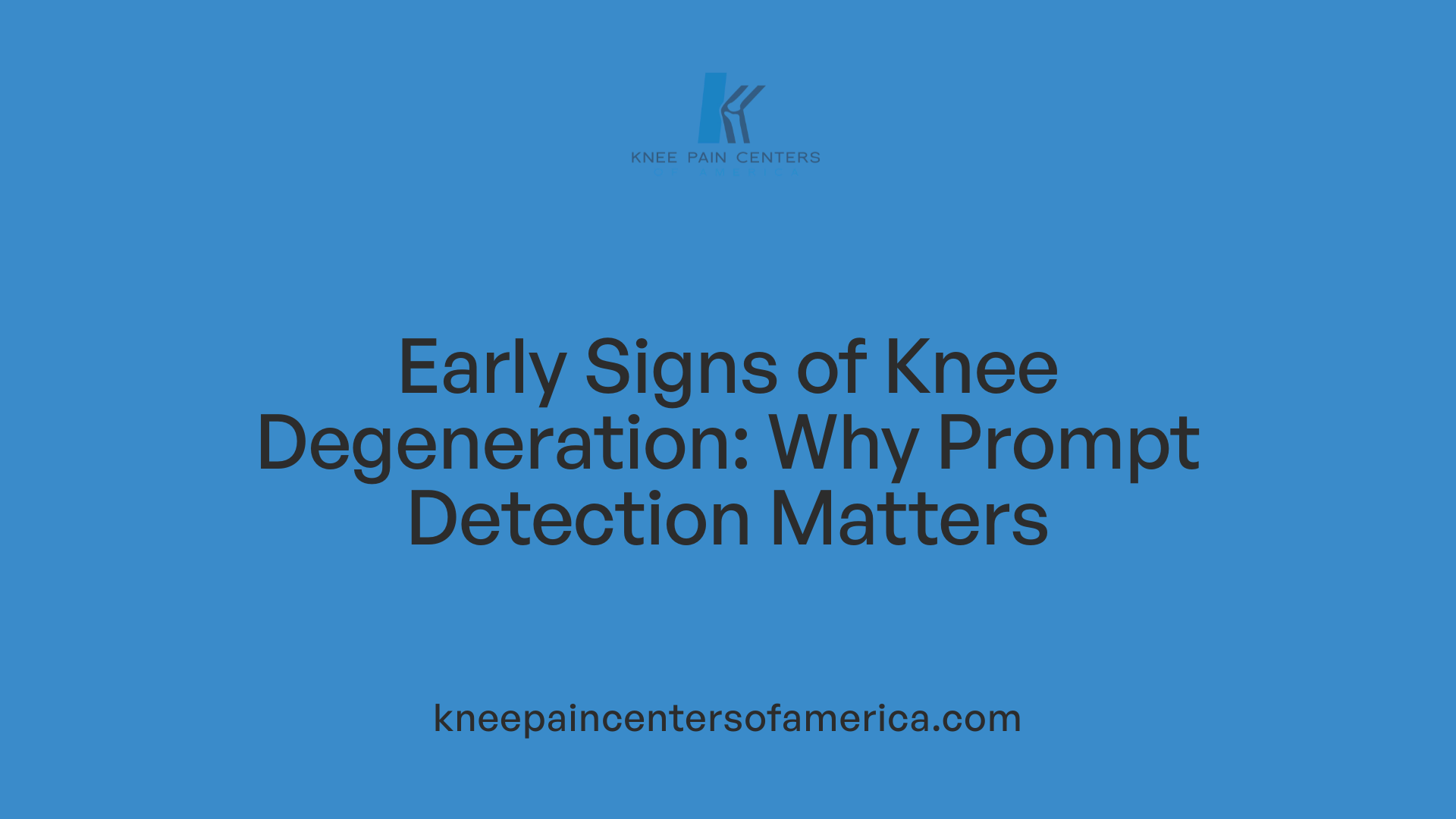
What are the early signs of joint degeneration in the knee?
Early symptoms of knee joint degeneration, commonly seen in conditions like osteoarthritis, can significantly affect daily activities. Patients often experience localized pain that worsens during or immediately after physical activity but tends to ease with rest. This pain pattern signals the beginning of cartilage deterioration and joint stress.
Joint stiffness is another common early symptom, particularly noticeable in the morning. This stiffness usually lasts less than 30 minutes, a phenomenon sometimes called the "gel phenomenon." It reduces the joint’s flexibility but tends to improve as the day progresses with movement.
Swelling and limited range of motion also appear as the joint becomes inflamed and the surrounding tissues respond to cartilage loss. The knee might feel puffy or warm, with mobility becoming increasingly restricted.
Audible joint noises such as clicking, cracking, or grinding (crepitus) are frequently reported. These sounds occur due to roughened cartilage surfaces or bone changes within the joint.
Instability, locking, and muscle weakness accompany the progression of degeneration. Patients may feel their knee wobble or give way, sometimes experiencing episodes where the knee locks, making movement difficult or painful.
Recognizing these early symptoms is crucial for seeking medical advice promptly. Early treatment can help manage symptoms effectively and slow further joint damage, improving quality of life over time.
Risk Factors Contributing to Knee Osteoarthritis Development

What factors increase the risk of developing knee osteoarthritis?
Risk factors include advanced age, female gender, obesity (especially BMI ≥30), prior knee injuries, repetitive high-stress activities or occupations, genetic predisposition, and anatomical abnormalities such as crooked bones or joint deformities.
Age and gender influences
Knee osteoarthritis (OA) is more common as people get older, primarily because cartilage wears down over time. Women are more frequently affected than men, possibly due to hormonal and structural differences.
Obesity and BMI impact
Carrying excess body weight significantly increases stress on knee joints, accelerating cartilage degradation. A Body Mass Index (BMI) of 30 or higher is strongly linked to higher osteoarthritis risk.
Previous knee injuries and overuse
Past injuries like ligament tears or fractures can alter joint mechanics, fostering OA development. Additionally, repetitive stress from high-impact sports or physically demanding jobs contributes to cartilage wear.
Genetics and structural deformities
Family history plays a role, with some people genetically predisposed to cartilage damage. Structural abnormalities such as crooked bones or joint deformities further increase the likelihood of developing knee OA.
Occupational and sports-related stress
Jobs or activities that involve frequent kneeling, squatting, or heavy lifting place extra strain on knee joints. Similarly, athletes engaged in high-impact sports face elevated risks due to repetitive joint stress.
| Risk Factor |
Description |
Impact on Knee OA |
| Age |
Natural cartilage degeneration over time |
Higher prevalence with aging |
| Gender |
Women affected more often |
Possible hormonal and anatomical reasons |
| Obesity (BMI ≥30) |
Increased mechanical load on joints |
Accelerates cartilage breakdown |
| Previous Knee Injuries |
Structural damage affecting joint function |
Increases OA risk through abnormal wear |
| Genetics |
Family predisposition to cartilage vulnerability |
Influences cartilage resilience and repair |
| Structural Deformities |
Bone alignment issues affecting load distribution |
Uneven stress promoting cartilage damage |
| Occupational/Sports Stress |
Repetitive joint loading/stress |
Causes accelerated cartilage degeneration |
Stages of Knee Osteoarthritis and Their Clinical Significance

What are the stages of knee osteoarthritis and what do they indicate?
Knee osteoarthritis develops gradually and is classified into four main stages that describe the severity of joint damage:
- Stage 1 (Minor): At this earliest phase, there is minimal cartilage degeneration and pain is usually mild or absent. Joint changes are subtle, often only detectable on imaging.
- Stage 2 (Mild): Cartilage begins to show noticeable wear leading to mild joint space narrowing. Patients may experience occasional pain and stiffness, especially after activity.
- Stage 3 (Moderate): Significant cartilage loss occurs, joint space narrowing becomes pronounced, and bone spurs (osteophytes) may develop. Symptoms like pain, swelling, stiffness, and reduced mobility become more persistent.
- Stage 4 (Severe): Extensive cartilage destruction results in bones rubbing directly against each other. This causes severe pain, joint instability, deformity, and marked loss of function.
Extent of cartilage loss and joint damage
The progression through stages generally correlates with increasing cartilage loss and joint deterioration. Radiographic imaging reveals joint space narrowing and osteophyte formation, particularly clear in stages 3 and 4. These structural changes underlie the worsening symptoms and functional impairment.
Progression of symptoms and joint impact
Symptoms worsen as knee osteoarthritis advances from minor to severe stages. Early on, patients may notice mild pain during activity and stiffness that eases with movement. With progression, pain becomes more constant, joints may swell, produce grinding sounds, lose stability, and in severe cases, lock or give way.
Importance of early stage recognition
Recognizing osteoarthritis at the minor or mild stages is crucial for effective management. Early interventions focusing on lifestyle changes, physical therapy, and symptom control can slow progression and improve quality of life. Delayed diagnosis often leads to advanced joint damage requiring surgical treatments.
| Stage |
Cartilage Condition |
Symptoms |
Imaging Findings |
Clinical Impact |
| 1 |
Minimal cartilage damage |
Little to no pain |
Subtle changes, normal joint space |
Usually asymptomatic |
| 2 |
Early cartilage wear |
Occasional pain and stiffness |
Mild joint space narrowing |
Activity-related discomfort |
| 3 |
Significant cartilage loss |
Persistent pain, swelling, stiffness |
Marked joint space narrowing, osteophytes |
Reduced mobility, functional decline |
| 4 |
Extensive cartilage loss |
Severe pain, instability, locking |
Severe joint space loss, large osteophytes, deformity |
Significant disability, surgical consideration |
Diagnostic Approaches for Confirming Joint Degeneration
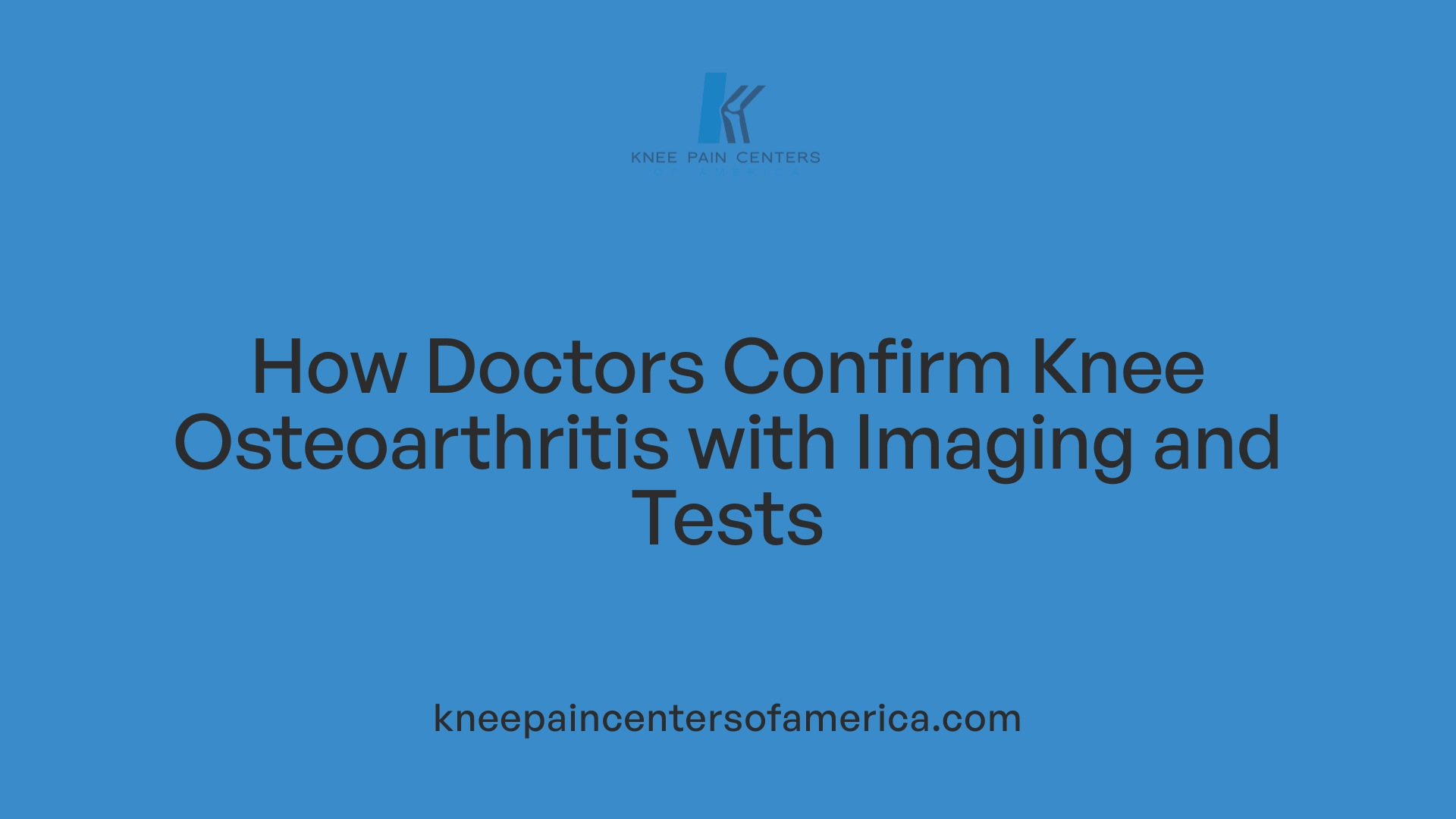
How is knee osteoarthritis diagnosed?
Diagnosing knee osteoarthritis begins with a thorough physical examination. Physicians assess swelling, tenderness, and the range of motion in the affected knee. They also evaluate joint stability to detect any wobbliness or locking that may accompany advanced stages.
Physical examination techniques
During the examination, signs such as bony enlargements, warmth, and crepitus (a crackling or grinding sensation) are carefully noted. Tenderness on passive motion and observations of gait abnormalities can further indicate joint degradation.
Range of motion and tenderness assessment
Evaluation of knee flexibility reveals stiffness common in osteoarthritis. Typically, patients exhibit reduced range of motion and pain, particularly after periods of rest or activity. Morning stiffness usually lasts under 30 minutes, a pattern known as the "gel phenomenon."
Imaging modalities: X-rays, MRI, CT scans
X-rays remain the most common imaging tool for detecting knee osteoarthritis. Key radiographic features include:
- Joint space narrowing, indicating cartilage loss
- Osteophyte formation (bone spurs), a hallmark of OA
- Subchondral sclerosis and cysts
MRI scans provide additional detail, allowing for visualization of cartilage condition and surrounding soft tissues, helping gauge disease progression and differentiate from other joint issues. CT scans are used less frequently but may assist in complex evaluations.
Lab tests for differential diagnosis
Laboratory tests, including joint fluid analysis and blood tests, are essential for excluding inflammatory or infectious causes such as rheumatoid arthritis or gout. These tests help confirm osteoarthritis as the primary diagnosis.
Radiographic features (joint space narrowing, osteophytes)
Radiographic signs offer clear evidence of joint degeneration. Joint space narrowing illustrates the extent of cartilage depletion, while osteophytes reflect the body's response to joint instability. Presence of these features correlates with symptom severity and guides treatment planning.
Understanding the Impact of Knee Osteoarthritis on Joint Function and Daily Life
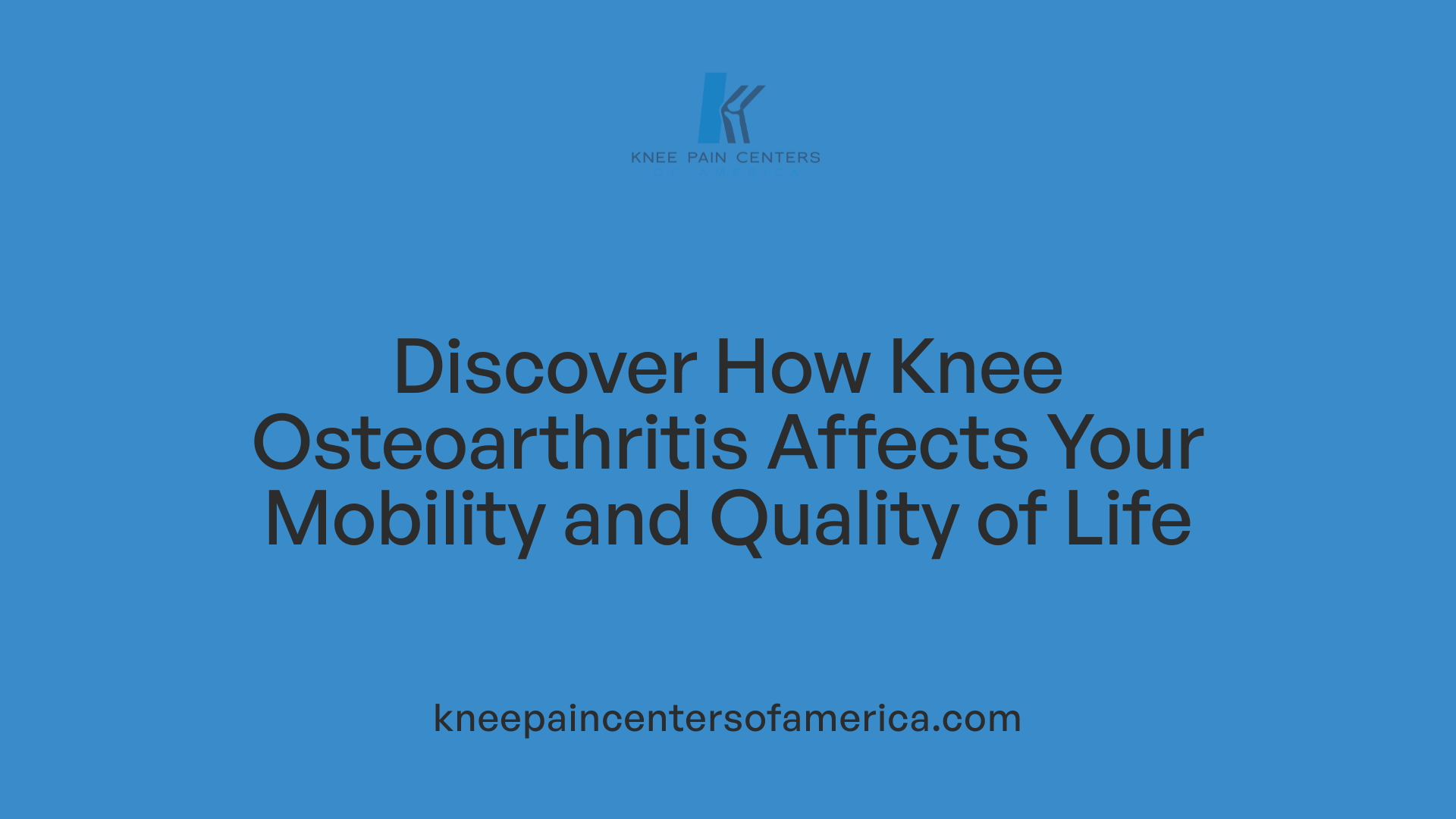
Symptoms affecting mobility
Knee osteoarthritis often manifests through pain, stiffness, and swelling in the joint. These symptoms limit the knee's range of motion and cause discomfort during movement, directly impacting mobility. Common complaints include cracking or grinding noises (crepitus) and sensations of the knee feeling unstable or wobbly.
Impact on walking, climbing stairs
Daily activities that require knee strength and stability, such as walking or climbing stairs, become challenging. The pain worsens with activity and may increase after periods of rest, leading to a reluctance to engage in physical movement. Over time, the cartilage degeneration worsens, making mobility progressively more difficult.
Pain during activity and rest
Initially, pain typically occurs during joint use and is relieved by rest. However, in severe osteoarthritis, pain may persist even at rest or during the night, significantly impacting sleep quality and overall well-being.
Joint locking and instability consequences
Advanced knee osteoarthritis can cause episodes of the knee locking or giving way, resulting from internal derangements. This symptom not only hampers movement but also raises the risk of falls and injuries, further limiting daily independence.
Mood and quality of life related issues
Chronic pain and decreased ability to perform everyday tasks can contribute to emotional distress and mood disorders. The persistent discomfort and functional limitations reduce quality of life, emphasizing the importance of early recognition and management of symptoms.
How does knee osteoarthritis affect a person’s daily activities?
Knee osteoarthritis causes pain, stiffness, swelling, and restricted joint movement, making it difficult to walk, climb stairs, and perform daily tasks. In advanced stages, joint locking and instability severely impair mobility and may also lead to mood problems due to ongoing pain and disability.
Non-Surgical Management Strategies for Early and Moderate Osteoarthritis
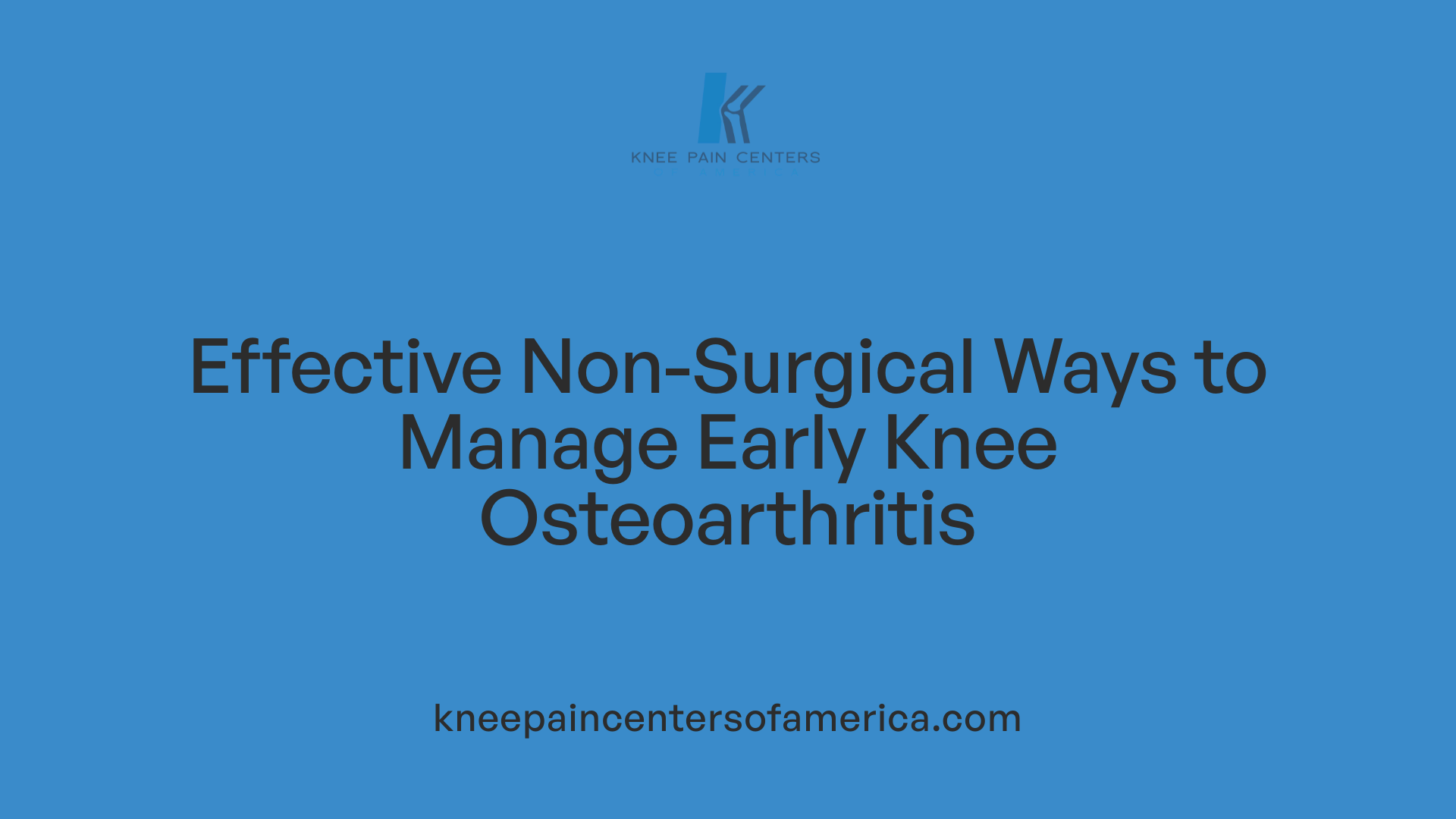
What are the nonsurgical treatment options for managing knee osteoarthritis?
Managing knee osteoarthritis without surgery focuses on relieving pain, improving joint function, and slowing disease progression through several effective strategies.
Pain Relief Medications
Common medications include nonsteroidal anti-inflammatory drugs (NSAIDs), acetaminophen, and duloxetine. NSAIDs reduce inflammation and pain, acetaminophen helps relieve mild to moderate pain, and duloxetine is used for chronic pain management. These medications help patients maintain function and reduce discomfort.
Physical and Occupational Therapy Benefits
Therapies aim to strengthen surrounding muscles, improve flexibility, and enhance joint stability. Tailored exercises can decrease joint stress, improve range of motion, and reduce stiffness, ultimately enabling better mobility and daily activity performance.
Weight Loss and Lifestyle Modifications
Reducing body weight significantly lowers stress on knee joints, which can alleviate symptoms and slow cartilage deterioration. Lifestyle changes also include adopting low-impact exercises like swimming or cycling, and avoiding activities that aggravate the knee.
Use of Braces and Assistive Devices
Knee braces and supportive devices help stabilize the joint, decrease pain during movement, and improve alignment. These aids provide external support, reducing load on damaged cartilage.
Intra-Articular Injections
When pain is not sufficiently managed by oral medications, injections may be recommended. Corticosteroid injections provide temporary relief by reducing inflammation, while hyaluronic acid injections enhance joint lubrication and cushioning.
By combining these nonsurgical treatments, individuals with early to moderate knee osteoarthritis can achieve significant symptom relief, improve joint function, and delay the need for surgery.
When and Why Surgical Intervention Becomes Necessary

When is surgery recommended for knee osteoarthritis and what are the options?
Surgical intervention for knee osteoarthritis is typically recommended when nonsurgical treatments such as medications, physical therapy, and injections fail to adequately relieve symptoms or when joint damage has progressed to a severe stage. This decision is often influenced by persistent pain, reduced mobility, and significant impairment in daily activities.
Types of surgical procedures
There are several surgical options available depending on the severity of osteoarthritis and patient factors:
High Tibial Osteotomy (HTO): This joint preservation surgery involves realigning the knee to redistribute weight away from the damaged cartilage. It is often recommended for younger, active patients who have arthritis localized to one compartment of the knee.
Partial Knee Replacement: Suitable for patients with damage confined to a single compartment, this surgery replaces only the affected part of the knee, preserving healthy bone and tissue.
Total Knee Replacement (Arthroplasty): Used in advanced or widespread cases, this procedure replaces the entire knee joint with prosthetic components to restore function and relieve pain.
Alternative advanced procedures
Other surgical interventions include:
Arthroscopy: A minimally invasive procedure used to remove loose cartilage or treat minor joint issues; however, its effectiveness for osteoarthritis is limited.
Synovectomy: The removal of inflamed synovial tissue, typically used when inflammation contributes significantly to symptoms.
Outcomes and recovery considerations
Recovery from knee surgery varies by procedure. Osteotomy typically requires a longer rehabilitation period focused on restoring alignment and strength. Knee replacement surgeries generally result in significant pain relief and improved mobility, but require careful postoperative rehabilitation.
Choosing the appropriate surgical procedure depends on factors such as age, activity level, disease severity, and overall health to optimize outcomes and improve quality of life.
Preventing and Slowing the Progression of Joint Degeneration
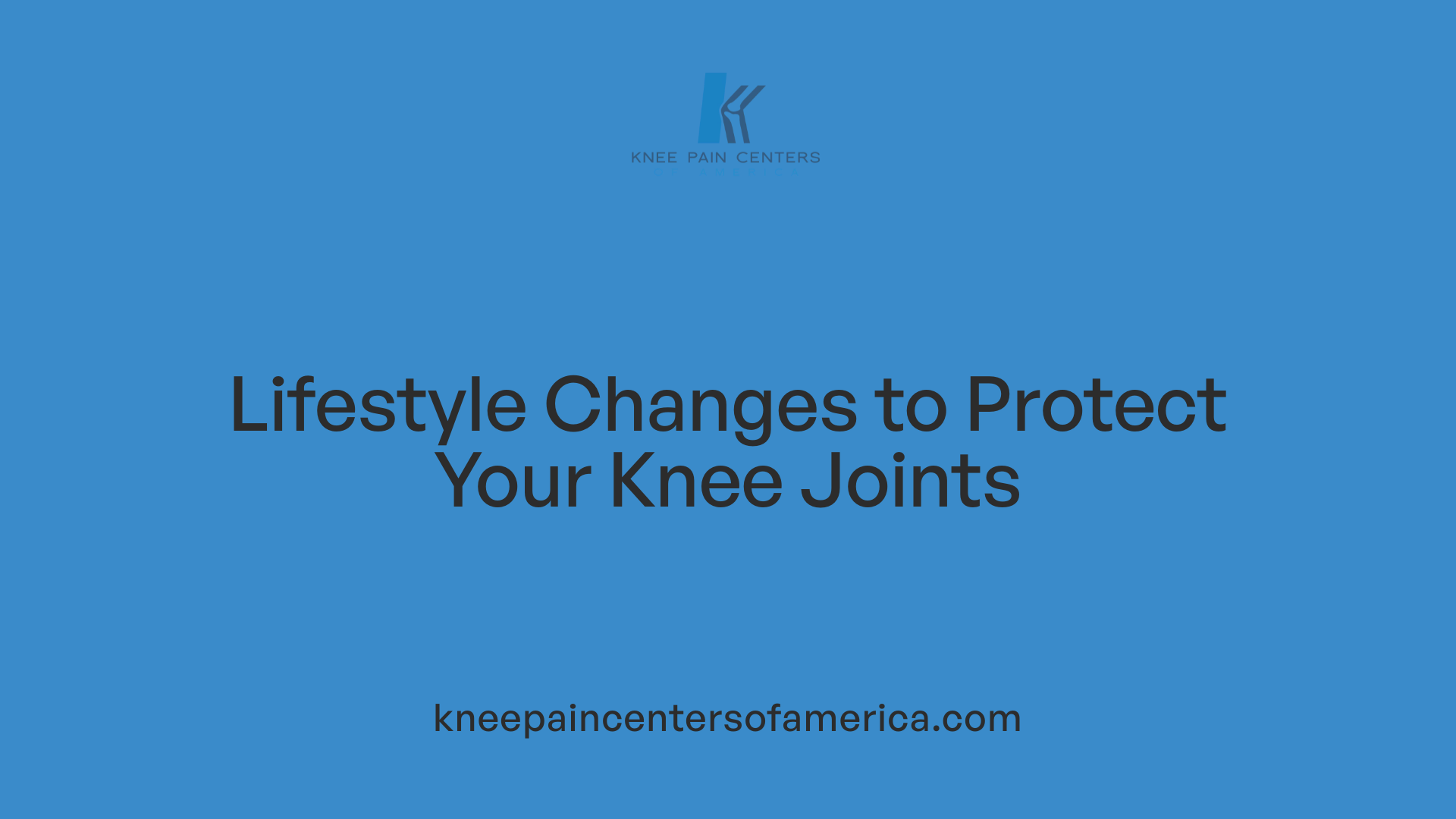
How can joint degeneration be prevented or slowed?
Preventing and slowing the progression of joint degeneration, especially in knee osteoarthritis, largely depends on lifestyle modifications aimed at reducing stress on the joints.
Lifestyle modifications
Maintaining an active lifestyle with proper activity adjustments is crucial. Avoiding high-impact activities that put excessive pressure on the knees, such as running on hard surfaces or frequent heavy lifting, helps protect the joint cartilage from further wear and tear.
Weight management
One of the most impactful steps is weight management. Excess body weight, particularly a Body Mass Index (BMI) of 30 or higher, increases the mechanical load on knee joints, accelerating cartilage deterioration. Losing even a small amount of weight can significantly reduce knee stress, relieve pain, and slow osteoarthritis progression.
Choosing low-impact exercises
Incorporating low-impact exercises such as swimming, cycling, tai chi, or yoga strengthens muscles around the knee without causing joint strain. These activities improve joint function, enhance flexibility, and help maintain a healthy range of motion.
Avoiding high-stress activities
Occupations or sports involving repetitive kneeling, squatting, or heavy lifting should be modified or limited to prevent excessive stress on the knee joints. Employing assistive devices or braces can further aid in distributing joint load during activities.
Protecting joint integrity
Protecting the knee through supportive braces or orthotic shoe inserts helps correct poor alignment and stabilize the joint. Additionally, avoiding injuries and promptly addressing knee trauma reduces the risk of secondary osteoarthritis.
Overall, a combination of maintaining a healthy weight, adapting activity choices, using supportive measures, and protecting joints from injury constitutes the most effective strategy to prevent or slow the progression of knee joint degeneration.
The Importance of Early Recognition and Patient Education
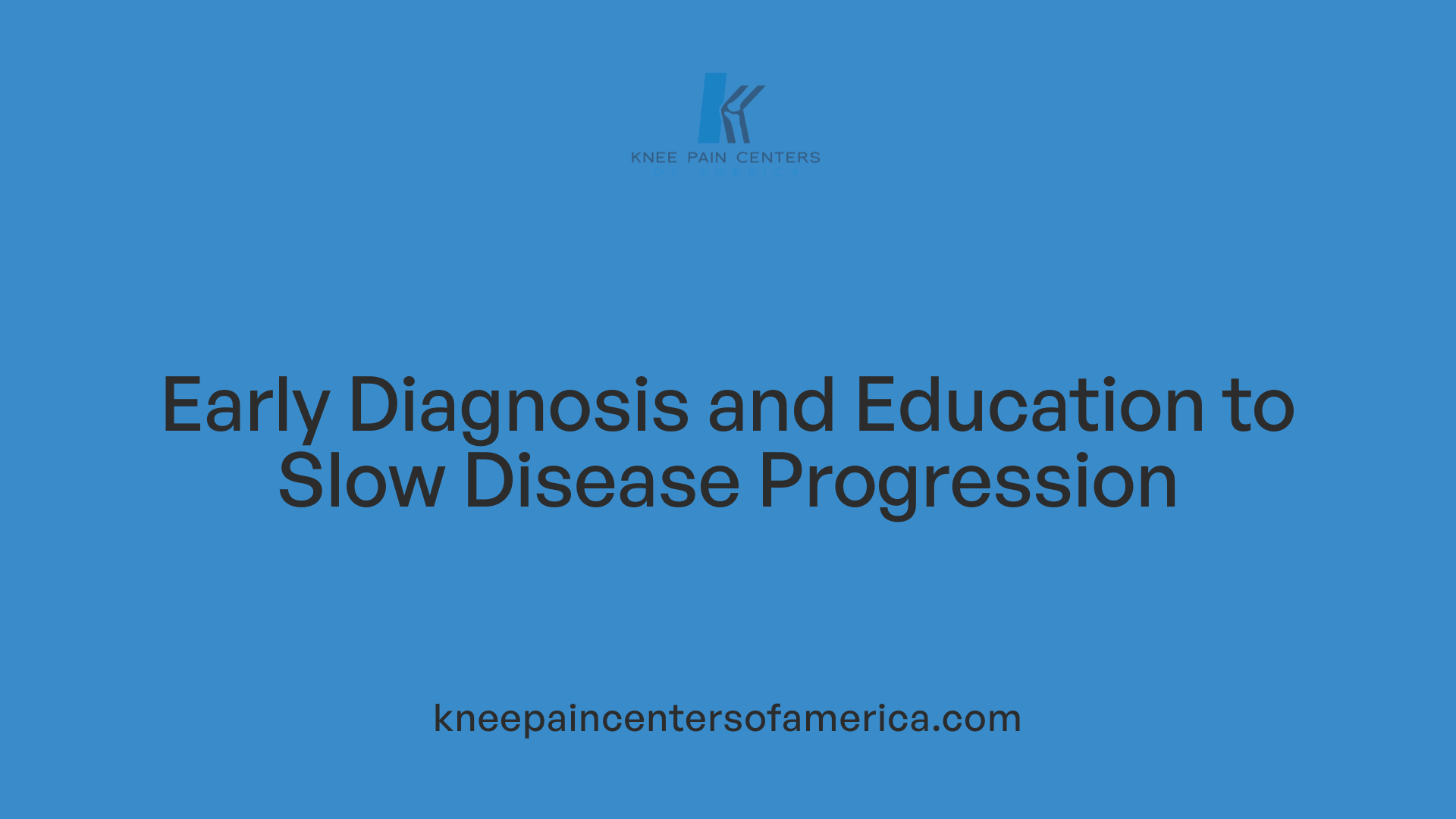
Why is early recognition of joint degeneration essential?
Early detection of knee osteoarthritis is crucial because it allows for timely interventions that can slow the progression of the disease. When symptoms such as joint pain, stiffness, or swelling are identified early, patients can begin management strategies that preserve joint function and alleviate discomfort. This early action often prevents or delays the onset of more severe symptoms like joint instability or locking.
Benefits of detecting symptoms early
By recognizing the initial signs of osteoarthritis promptly, patients can access treatments such as physical therapy, weight management, and medications that reduce inflammation and pain. Early symptom detection also helps in identifying contributing risk factors, enabling lifestyle adjustments that minimize joint stress. These benefits collectively improve mobility and quality of life.
Role of education in self-care and management
Patient education plays a pivotal role by informing individuals about causes, symptoms, and available treatments for osteoarthritis. Knowledge about low-impact exercises, proper body mechanics, and the importance of maintaining a healthy weight empowers patients to take control of their condition. Educational efforts encourage adherence to therapy and foster proactive self-care habits.
Encouraging lifestyle changes and adherence to therapy
Education supports behavior modification by highlighting the advantages of weight loss, regular gentle exercise, and avoiding high-impact activities that stress the knees. It also helps patients understand the importance of adhering to medications, attending physical therapy sessions, and using assistive devices when needed. Encouragement and guidance increase the likelihood of sustained engagement in these beneficial practices.
Improving outcomes through timely intervention and reducing long-term disability
Timely intervention combined with well-informed self-management reduces the severity of pain, slows cartilage deterioration, and can delay or even prevent the need for surgical procedures. Ultimately, early recognition paired with patient education diminishes the risk of long-term disability while enhancing overall joint health and function.
Supporting Patients with Osteoarthritis: Holistic and Multidisciplinary Approaches

What comprehensive care approaches support patients with knee osteoarthritis?
Effective management of knee osteoarthritis goes beyond symptom treatment and requires a holistic, multidisciplinary approach.
Physical therapy and tailored exercise programs
Physical therapy is essential to strengthen the muscles around the knee, enhance flexibility, and maintain joint function. Customized exercise regimens, including low-impact activities like swimming, tai chi, and yoga, help reduce pain and improve mobility without over-stressing the joint.
Nutritional guidance and weight control
Since obesity is a major risk factor for knee OA, nutritional counseling plays a critical role. Maintaining or achieving a healthy weight reduces joint load and slows disease progression. Diet plans emphasizing anti-inflammatory foods and balanced nutrition support overall joint health.
Pain management including alternative therapies
Pain relief strategies combine medications such as NSAIDs and acetaminophen with alternative treatments like acupuncture, nerve blocks, platelet-rich plasma injections, and cortisone shots. These therapies help manage inflammation and reduce discomfort.
Mental health considerations
Knee osteoarthritis can lead to mood disorders due to chronic pain and mobility limitations. Psychological support, including counseling and stress reduction techniques, is important to improve patients' quality of life.
Coordinated care between specialists
Optimal management requires collaboration among rheumatologists, orthopedic surgeons, physical therapists, nutritionists, and mental health professionals to tailor and adjust treatment plans. This coordinated team effort ensures comprehensive care addressing all aspects of the disease.
| Care Aspect |
Role in Management |
Typical Interventions |
| Physical Therapy |
Improve joint function and reduce stress |
Strengthening exercises, range-of-motion therapy |
| Nutritional Guidance & Weight Control |
Decrease joint load, limit progression |
Weight loss programs, anti-inflammatory diet advice |
| Pain Management |
Alleviate symptoms |
NSAIDs, corticosteroid injections, alternative therapies |
| Mental Health Support |
Address emotional impact of chronic disease |
Counseling, stress management, support groups |
| Coordinated Multispecialty Care |
Personalized comprehensive treatment |
Collaboration between medical providers, ongoing assessment |
This multidisciplinary framework enhances symptom control and helps patients maintain an active, fulfilling lifestyle despite knee osteoarthritis.
Taking Action Early to Preserve Joint Health
Recognizing the early signs of knee joint degeneration is critical to effective management and improving patient outcomes. Knee osteoarthritis, a common degenerative disease, progresses gradually but can be visibly detected and treated early through attentive symptom recognition, diagnostic evaluation, and targeted interventions. Lifestyle modifications, pharmacologic treatments, and when necessary, surgical options offer comprehensive paths to preserving joint function and enhancing quality of life. Empowering individuals through education and multidisciplinary care ensures that joint degeneration is addressed proactively, reducing disability and maintaining mobility for years to come.
References